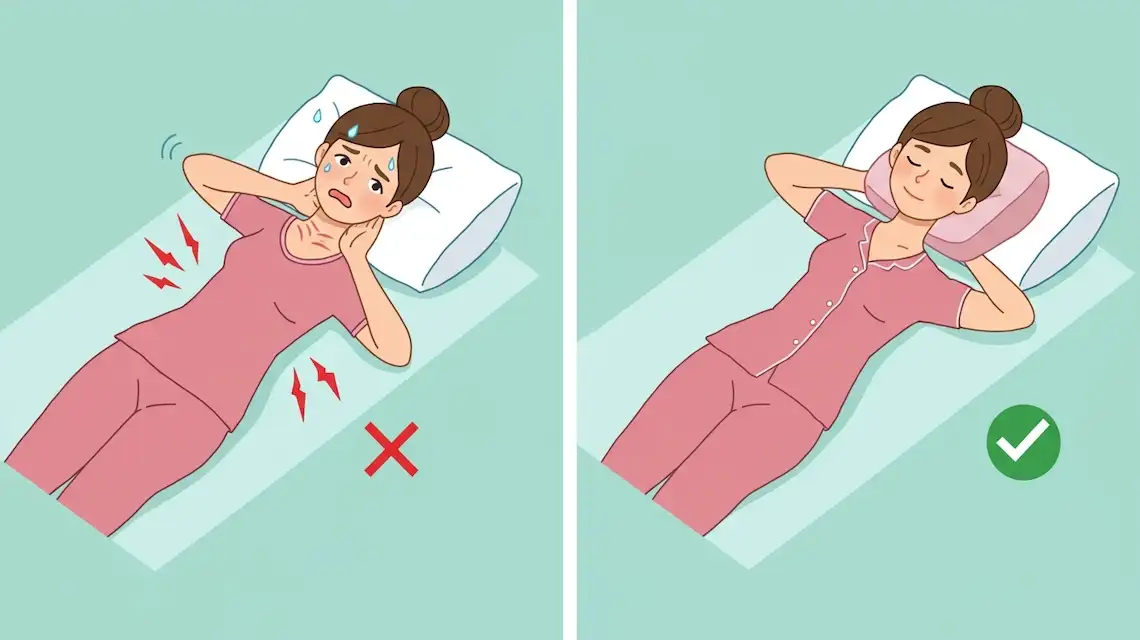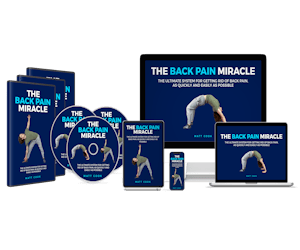Nights feel long when your back aches and mornings can feel stiff before you even stand up. If you have been wondering how to sleep with lower back pain, you are not alone. This guide gives clear, simple steps based on body mechanics and sleep science so you can rest tonight.
Small changes add up. Try one change per night and adjust based on what your body tells you. You will learn easy sleep positions, smart bed setup, and a calm routine that helps pain settle. Red flags and when to see a clinician are covered near the end. Keep the gear simple, the moves gentle, and the focus on a neutral spine.
How to sleep with lower back pain tonight: positions that reduce pressure
Your spine likes neutral, not bent or twisted. When your spine rests in a neutral line, muscles let go and nerves get more room. This is why side or back sleeping usually beats stomach sleeping for lower back pain.
Start by getting comfortable in a position that protects your lower back. Use pillows to fill gaps, keep the pelvis level, and reduce strain. Move slowly and breathe. If you need to switch sides at night, turn with your whole body, not just your hips or waist.
- For side sleeping, place a pillow between your knees. Add a small pillow at your waist if there is a gap. A slight curl can ease pressure, but avoid a tight tuck.
- For back sleeping, slide a pillow under your knees. Add a small towel roll at your lower back if it feels good. Keep your head pillow low.
- If you must sleep on your stomach, use a thin pillow under your hips and ankles. Keep the head pillow flat or skip it.
To switch sides at night, bend both knees, roll as one unit, then adjust your pillows before settling. This keeps the spine stable. For sciatica or leg pain, many people prefer lying on the side opposite the painful leg. It reduces tension on the irritated nerve and can calm the burning or zapping feeling.
Side sleeping with a pillow between your knees
A firm pillow between your knees keeps your hips level so your lower back does not twist. Stack your knees and ankles, then place the pillow so it fills the space from knee to ankle. If your waist lifts off the mattress, slide a small pillow or folded towel under that side to fill the gap.
Use a light fetal curl, not a tight ball. Think gentle curve, not crunch. This softens the pull on the lower back. Switch sides once or twice to avoid soreness on one hip.
Tip for sciatica: if your right leg burns, try lying on your left side. The top leg can rest on a pillow in front of you for comfort.
Back sleeping with a pillow under your knees or a small lumbar roll
A pillow under your knees tilts your pelvis in a way that reduces pull on the lumbar spine. This is simple and often very effective. If you like a little support at your lower back, tuck a small rolled towel at the natural curve, not too tight.
Keep your head pillow low. A high pillow can push your chin forward, which can stress your neck and upper back. If leg pain travels down, a wedge under your lower legs can help. Aim for hips and knees slightly bent, like a gentle recline.
Is it OK to sleep on your stomach with back pain?
Stomach sleeping is usually not ideal. It twists the neck and extends the lower back, which can set off pain. If you must, use a thin pillow under your hips and ankles. Use a very flat head pillow or none at all to reduce neck strain. Try a half prone setup by hugging a body pillow. It keeps one hip less rotated and your spine closer to neutral.
Turn and get out of bed without a pain spike
Use the log roll. Bend both knees, roll to your side as one unit, let your legs drop off the edge, then push up with your arms to sit. Reverse the steps to lie down. Moving the spine as a single piece lowers strain on irritated joints and discs.
Move slow. Brace your core gently, as if zipping up your midsection. Exhale during the effort. This simple habit can cut those sharp morning zings.
Set up your bed for back support: mattress, pillows, and simple aids
Comfort and support work together. Your mattress should keep your spine aligned while easing pressure points at the shoulders and hips. Your pillows should fill the gaps your body leaves, not force your head or hips into odd angles. Small, low-cost fixes can make a big difference.
For most people with lower back pain, a medium-firm feel supports the waist and hips without creating hot spots. Pillow height depends on how you sleep. Side sleepers need more loft so the neck stays level. Back sleepers need less loft so the chin does not tilt. Add small aids, like a rolled towel or knee pillow, to fine-tune.
Do a quick safety check too. Bed height should make it easy to stand, the path to the bathroom should be clear, and your nightly tools should be within reach. Your room should help you relax, not trip you up.
Best mattress firmness for lower back pain
Many people sleep best on a medium firm mattress. It balances support and pressure relief. That said, body weight and position matter. A lighter person often prefers a touch softer. A heavier person might need a bit firmer to keep the hips from sinking too far.
If possible, test a mattress for 30 to 90 nights. Your body needs time to adjust. Foam, latex, and hybrid beds can all work. Pick the feel that keeps your spine level and your shoulders and hips happy. If your mattress is old or sagging, a new one helps more than gadgets.
Pillows that help your lower back
Match pillow height to how you sleep. Side sleepers generally need a thicker pillow so the neck lines up with the spine. Back sleepers often do better with a medium or lower loft. Stomach sleepers, if they insist, should go very flat.
- For side sleeping, use a knee pillow or any firm pillow between your knees.
- For back sleeping, try a small lumbar roll or a rolled towel at your lower back.
- If you feel better with a slight incline, a wedge pillow under your upper body can help, especially if you have reflux or snore.
Mattress toppers and budget fixes that work
A 2 to 3 inch memory foam or latex topper can soften a bed that feels like a board. If only part of you needs support, slide a folded blanket under your hips or shoulders to fine-tune. A full-length body pillow can keep your chest, hips, and knees aligned so you do not twist.
Be careful with plywood under a mattress. It can make pressure points worse, even if it adds support. Test before you commit.
Bed setup and room ergonomics
Set bed height near your knee level so standing is easier. If the bed edge is soft, sit where it is firmer or place a stable ottoman nearby to help you rise without straining. Keep a clear path to the bathroom and remove throw rugs that slip.
Set a heating pad, water, and your night meds within reach. Keep the room cool, dark, and quiet. Small tweaks lower stress on your back and your nerves.
Bedtime routine that calms pain and helps you fall asleep
A relaxed body sleeps better and hurts less. Build a simple routine that you repeat each night. Start with gentle mobility, add heat or ice based on what feels best, consider over the counter pain relief if safe, then wind down your mind.
Consistency matters. Use slow, smooth moves. If a stretch causes sharp pain, skip it. The goal is comfort, not forcing range. Over a week, your back often learns to settle earlier in the night.
A 5-minute gentle stretch routine
Try this short sequence in bed or on a mat:
- Pelvic tilts, 5 to 6 slow breaths. Flatten your lower back to the bed as you exhale, then relax.
- Single knee to chest, 5 breaths each side. Hold behind the thigh, not the knee.
- Figure 4 stretch if it feels safe, 5 breaths each side. Cross ankle over knee, pull the thigh toward you.
- Child’s pose or prayer stretch, 5 to 6 breaths. Hips back, arms forward, relax your jaw.
- Diaphragmatic breathing for 1 to 2 minutes. One hand on belly, slow inhale through the nose, longer exhale through the mouth.
Move slow, no bouncing. Stop any move that gives sharp or spreading pain.
Heat or ice before bed: what helps most?
Heat often relaxes tight muscles and eases stiffness. Ice can calm a fresh flare or reduce a hot, throbbing feeling. Try 10 to 15 minutes with a cloth layer to protect your skin. Some people like heat first, then remove it before sleep.
Never sleep on an active heating pad. Test each option for a few nights to see what your back prefers.
Over-the-counter pain relief and topicals
Some people sleep better with acetaminophen or an NSAID, taken 30 to 60 minutes before bed, if safe for them. Read labels and avoid stacking similar drugs. If you are unsure, pregnant, or have medical conditions, check with a clinician first.
Topical options can help sore spots without upsetting your stomach. Menthol rubs can distract from pain. Diclofenac gel can ease joint ache when used as directed.
Sleep habits that support a calmer back
Keep a steady sleep and wake time. Dim lights in the last hour. Limit screens or use a blue light filter. Avoid heavy meals at night. Skip caffeine late, alcohol near bedtime, and nicotine.
Use simple breathing like box breathing or 4-7-8. Keep a notepad to park worries. If pets push you into awkward angles, keep them off the bed. Protect your position so your back can rest.
Troubleshooting: when pain ruins sleep and when to see a pro
When pain wakes you, start with fast fixes. Shift to a position that supports your spine. Add or remove a knee pillow. Do 2 minutes of pelvic tilts and a slow breath set. Small moves can quiet a flare.
Watch for warning signs too. Some symptoms call for prompt medical care, not waiting it out. Travel and pregnancy have special needs, so plan for extra support. If sleep does not improve after a few weeks of smart changes, a clinician can help tailor a plan.
Night pain red flags you should not ignore
Seek urgent care for:
- New leg weakness
- Numbness in the saddle area
- Loss of bladder or bowel control
- Fever or chills with back pain
- Unexplained weight loss
- History of cancer
- Recent serious fall
- Severe, constant night pain that does not ease with position changes
If you wake up stiff or sore, adjust these first
Try switching from stomach to side or back. Add or remove a knee pillow to find a better hip angle. Place a small towel at your waist or lower back gap. Before getting up, do 2 minutes of gentle pelvic tilts.
In the morning, walk for 5 minutes and apply brief heat. Movement and warmth loosen tight muscles and get blood flowing.
Travel and flare-up tips for sleeping away from home
Ask for extra pillows to build knee or waist support. Roll a towel to use as a lumbar roll in a chair or in bed. On long trips, stand and move every 60 to 90 minutes. Stretch calves and hips at each stop.
If a hotel bed feels too soft, sleep closer to the edge where it is firmer. Some hotels offer toppers on request. Keep your log roll habit in any bed.
Pregnancy and lower back pain sleep tips
Side sleeping, often the left side, is usually most comfortable. Place a pillow between your knees and another at your belly or against your back. Use the log roll to get out of bed safely. Avoid overheating and heavy stretching at night.
If swelling, numbness, or severe pain appears, contact your prenatal clinician. Your comfort matters for you and your baby.
Conclusion
Sleep improves when you protect a neutral spine, use smart bedding, and follow a calm routine. Try one change tonight, like a knee pillow or a 5 minute stretch set. Keep notes for a week to see what helps most. If you still wonder how to sleep with lower back pain, start with side or back sleeping and build from there.
Watch for red flags and check in with a clinician if symptoms worry you or sleep does not improve. Small tweaks, repeated, often lead to steady gains. Your back can learn to relax, and your nights can feel quiet again. Stay patient and keep it simple. Your next good night may be closer than you think.
What Exercise Can Help With Lower Back Pain
Lower Back Muscle Strain Treatment Exercises
Better Sleep With Lower Back Pain: FAQ
What sleep position is best for lower back pain?
Side sleeping with a pillow between your knees helps keep your spine neutral. Back sleeping can work too, place a pillow under your knees. Avoid stomach sleeping, it strains your back. If you must, use a very thin pillow under your hips and lower belly.
How do I align my spine while I sleep?
Keep your ears, shoulders, and hips in a straight line. Use a pillow that fills the space between your neck and mattress. Place support under or between your knees based on your position. Your goal is a neutral spine, not a flat back.
Should I sleep on a firm or soft mattress?
Research favors medium-firm for chronic lower back pain. Too soft lets your hips sink, which twists the spine. Too firm can create pressure points and tension. If you can’t replace a mattress, try a medium-firm topper.
What kind of pillow should I use?
Pick a height that keeps your neck level with your spine. Side sleepers usually need a thicker pillow. Back sleepers do better with a medium height pillow. Consider a small lumbar roll for the curve of your lower back.
Can heat or ice help before bed?
Yes. Use heat for 15 to 20 minutes to relax tight muscles before sleep. Use ice for 10 to 15 minutes after a flare or activity to calm irritation. Don’t fall asleep with heat or ice on your skin.
Are there stretches I can do at night?
Try gentle moves, not deep bends. Good options: knees-to-chest, pelvic tilts, child’s pose, figure-4 stretch. Hold 20 to 30 seconds, breathe slow, stop if pain shoots down a leg. Save intense stretching for daytime.
What should I avoid before bedtime?
Skip heavy lifting or hard workouts late at night. Avoid big meals, alcohol, and nicotine. Limit screens and bright light in the hour before bed. Caffeine after midafternoon can make pain feel worse and cut sleep.
How do I get in and out of bed without hurting my back?
Use the log roll. Roll to your side, drop your legs off the bed, push up with your arms together. To lie down, reverse the steps. Keep your core tight and move in one piece.
Why do I wake up with more pain in the morning?
Your joints can stiffen overnight, and poor support makes it worse. A sagging mattress or high pillow can twist your spine. Inactivity and cool rooms may also add stiffness. If morning pain lasts over 30 minutes most days, talk with a clinician.
What if my pain shoots down my leg at night?
This can be sciatica from nerve irritation. Try side sleeping with a pillow between your knees, or back sleeping with knees supported. Avoid stomach sleeping and deep forward bends. If weakness, numbness, or bladder changes appear, seek care now.
How do I sleep if I’m pregnant with lower back pain?
Sleep on your left side with a pillow between your knees. Place another pillow under your belly for support. A firm pillow behind your back can stop rolling to your stomach. Talk with your OB if pain wakes you often.
Do sleep meds help with back pain?
Short-term use of acetaminophen or NSAIDs can help some people. Check with your clinician if you have kidney, stomach, heart, or bleeding risks. Topical creams with NSAIDs or lidocaine may help targeted spots. Avoid new sleep meds without guidance.
Can weight, stress, or mood affect sleep and back pain?
Yes. Extra weight can strain the spine, and stress increases muscle tension. Gentle activity, walking, or core work helps over time. Use simple wind-down habits like breath work or a short body scan before bed.
What’s a simple bedtime routine for fewer flare-ups?
Warm shower, light stretch, heat for 15 minutes, then read or listen to calm audio. Keep the room dark, cool, and quiet. Aim for a consistent sleep and wake time. Put your phone away 30 to 60 minutes before bed.
Are there sleep products that actually help?
A medium-firm mattress or topper often helps. Knee pillows, body pillows, or a small lumbar roll can keep alignment. Consider a wedge under the knees if you sleep on your back. Replace worn-out pillows every 1 to 2 years.
When should I see a doctor about night pain?
Get urgent care for new severe weakness, numbness in the groin, fever, cancer history, unexplained weight loss, major trauma, or loss of bladder or bowel control. See a clinician soon if pain lasts longer than 4 to 6 weeks, wakes you nightly, or limits daily life. Early treatment can prevent a longer setback.
Can I still exercise if my back hurts at night?
Yes, gentle movement helps most backs. Try walking, swimming, or stationary cycling. Add core work like bird-dog and dead bug, two to three days a week. Stop any move that causes sharp or spreading pain.
What if I sleep fine at home but hurt when traveling?
Pack a small pillow or lumbar roll. Ask hotels for extra pillows or a board under the mattress to reduce sag. Stretch after long flights or drives. Keep your usual bedtime and wind-down routine as close as you can.




 Natural Remedies for Earache
Natural Remedies for Earache  How To Remove Sun Tan From Hands
How To Remove Sun Tan From Hands  Can a Mattress Make You Sore?
Can a Mattress Make You Sore?  How to Take Care Your Nails
How to Take Care Your Nails  How Do You Put a Newborn to Sleep?
How Do You Put a Newborn to Sleep?  How to Improve Good Cholesterol (HDL)
How to Improve Good Cholesterol (HDL)